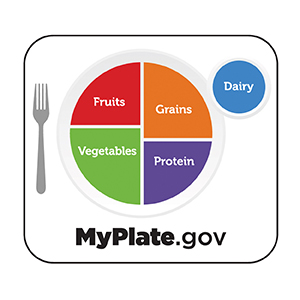Nutrition: Toddler
Helpful feeding information for your toddler
Feeding toddlers (ages 1 to 3) can often be challenging. That's because several developmental changes are happening at this time. Toddlers are striving for independence and control. Their growth rate slows down, and with this often comes a decrease in appetite. These changes can make mealtime difficult. It's important for parents to provide structure and set limits for the toddler. These suggestions can help manage mealtimes so that your toddler gets the nutrition they need:
-
Avoid battles over food and meals. Try to make mealtimes pleasant.
-
Turn off distractions like the TV, tablets, cellphones, and other electronics during mealtime.
-
Provide regular meals and snacks. Don't let your child graze.
-
Be flexible with food acceptance as toddlers are often reluctant to try new things. If your toddler refuses food, don't make a big deal out of it. Try again in a few days or weeks. It can take up to 12 times or more before a child comes to accept a new food.
-
Be realistic about food amounts. Portion size should be about 1/4 the size of an adult portion.
-
Don't make your child "clean" their plate. This can lead to overeating and an unhealthy relationship with food.
-
Limit juice intake. Encourage whole fruit instead.
-
Don't let your child fill up on juice or milk in between meals. This will make them less hungry during mealtimes. If your child is thirsty between meals, offer water.
-
Don't use dessert as a reward. Try serving it with the rest of the food.
-
Make the food easy for your toddler to eat:
-
Cut food into bite-size pieces.
-
Make some foods soft and moist.
-
Serve foods near room temperature.
-
Use ground meat instead of steak or chops.
-
Use a child-size spoon and fork with dull prongs.
-
Seat your child at a comfortable height in a secure chair.
-
Prevent choking by:
-
Slowly adding more difficult-to-chew foods.
-
Staying away from foods that are hard to chew or swallow. These include chips, nuts, raw carrots, gum drops, jellybeans, and large amounts of peanut butter.
-
Modifying high-risk foods. Cut hot dogs in quarters, cut grapes in quarters, and cook carrots until soft.
-
Always supervising your child when they are eating.
-
Keeping your child seated while eating.
Healthy food choices
The MyPlate icon is a guideline to help you and your toddler eat a healthy diet. MyPlate focuses on eating a variety of foods while encouraging the right amount of calories and fat. The USDA and the U.S. Department of Health and Human Services have prepared the food plate to guide parents in selecting foods for children ages 1 and older. The MyPlate plan is designed for people older than age 1 who don't have long-term (chronic) health conditions.

The MyPlate icon is divided into five food group categories, emphasizing the nutritional intake of the following:
-
Grains. Foods that are made from wheat, rice, oats, cornmeal, barley, or another cereal grain are grain products. Examples include whole-wheat, brown rice, and oatmeal. Aim for mostly whole grains.
-
Vegetables. Vary your vegetables. Choose a variety of colorful vegetables. Include dark green, red, and orange vegetables, legumes (peas and beans), and starchy vegetables.
-
Fruits. Any fruit or 100% fruit juice counts as part of the fruit group. Fruits may be fresh, canned, frozen, or dried. They may be whole, cut up, or pureed. The American Academy of Pediatrics advises limiting juice to less than 4 ounces per day for children 1 to 3 years old.
-
Dairy. Milk products and many foods made from milk are considered part of this food group. Focus on fat-free or low-fat products, as well as those that are high in calcium.
-
Protein. Go lean on protein. Choose low-fat or lean meats and poultry. Vary your protein routine. Choose more fish, nuts, seeds, peas, and beans.
Oils aren't a food group. But some foods are natural sources of oils and should be included in the diet. These include nuts, some fish, olives, and avocado. Limit animal fats.
Include active play and everyday physical activity along with a healthy dietary plan.
Nutrition and activity tips
Here are some tips to follow:
-
Try to control when and where food is eaten by your toddler by keeping regular daily mealtimes. Provide social interaction and model healthy eating behaviors.
-
Include your child in choosing and preparing foods. Teach them to make healthy choices by helping them select foods based on their nutritional value.
-
Choose foods with these nutrients when possible: calcium, magnesium, potassium, and fiber.
-
Follow the recommended serving sizes for children.
-
Try to limit your child’s screen time to less than 1 hour daily. Instead, encourage activities that require more movement.
-
Children need at least 60 minutes of moderate to vigorous physical activity on most days for good health and fitness. This is also for healthy weight during growth.
-
To prevent dehydration, encourage your child to drink fluids regularly during physical activity. They should also drink a few glasses of water or other fluid when the physical activity is over.
Always talk with your toddler’s healthcare provider regarding their personal diet and exercise needs.
To learn more
For more information, check out these resources:
Online Medical Reviewer:
Chris Southard RN
Online Medical Reviewer:
Marianne Fraser MSN RN
Online Medical Reviewer:
Rajadurai Samnishanth
Date Last Reviewed:
1/1/2024
© 2000-2024 The StayWell Company, LLC. All rights reserved. This information is not intended as a substitute for professional medical care. Always follow your healthcare professional's instructions.